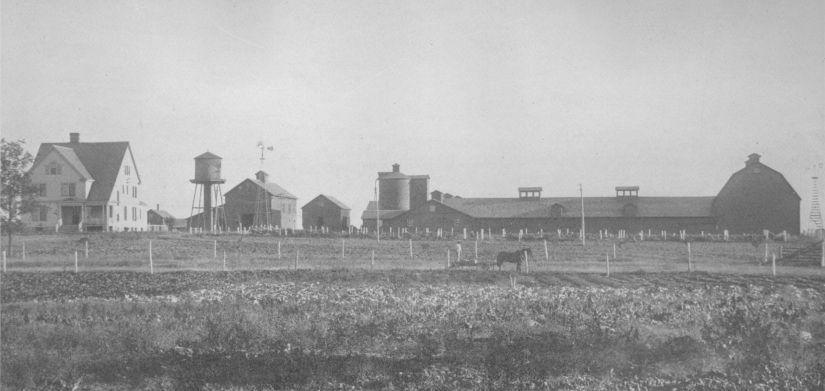By the turn of the 20th century, the Michigan Home for the Feeble-Minded and Epileptic was no longer just a small collection of cottages on 160 acres. In less than a decade, it had begun to transform into something far larger—an entire community within itself. What started with fewer than 150 residents would soon swell into the thousands. The institution, later known as Oakdale, would become a miniature city, complete with its own farms, school system, workshops, recreation programs, and a workforce that rivaled many small towns.
This rapid expansion wasn’t accidental. It reflected the national belief in the “institutional solution”—that the best way to manage people with epilepsy and developmental disabilities was to house them in large, centralized facilities where they could be trained and supervised. In Michigan, Oakdale became the embodiment of that philosophy.
A City Within a City
By the 1920s, the campus had grown dramatically. New dormitories rose across the property, built in the same cottage style but multiplied many times over. There were now dozens of buildings, arranged like neighborhoods, and connected by wide lawns and pathways.
But Oakdale was more than a residential institution. It operated like a self-sufficient village. It had its own:
-
Dairy farm with over 200 cows, producing milk and butter for residents and staff.
-
Bakery that turned out thousands of loaves of bread each week.
-
Slaughterhouse, gardens, and orchards, ensuring a steady food supply.
-
Laundry and power plant, keeping the campus running without reliance on outside utilities.
-
Workshops, where residents repaired furniture, made clothing, and assisted with other maintenance tasks.
This wasn’t just for efficiency—it was part of the institution’s philosophy. Residents who were physically able were expected to work. The superintendent’s reports described this as “therapeutic training,” but in practice it meant labor was woven into daily life, keeping the institution economically sustainable.
Peak Population and Expansion
The numbers tell the story of Oakdale’s staggering growth. By the 1940s, the campus covered over 1,100 acres and included nearly 100 buildings. The population of residents reached more than 4,600, making it the largest institution of its kind in the Midwest.
With that many people, Oakdale developed its own social and cultural life. There was a school on campus, where children received basic education. A chapel hosted regular services. There was even a resident band, which performed at events both inside and outside the grounds. Staff organized picnics, dances, and holiday celebrations.
Many employees lived on-site or nearby, creating an intertwined community of workers and families whose lives were shaped by the institution. For decades, Oakdale was the largest employer in Lapeer County, providing steady income during the Great Depression and beyond. Entire generations of local families worked there as attendants, nurses, cooks, or maintenance staff.
Residents’ Lives and Routine
Daily life for residents was structured, predictable, and controlled. Mornings began early with roll calls and chores. Those who could work were assigned to farming, kitchen duty, laundry, or other institutional needs. Others attended classes or therapy sessions. Evenings were quiet, with limited recreation and strict curfews.
For some, the routine provided stability they had never experienced before. For others, it was stifling—a life stripped of personal choice. Residents often stayed for decades. Many never left.
Despite its size, Oakdale maintained an internal culture that was part school, part hospital, and part prison. The residents were still referred to in official documents as “inmates,” reflecting the belief that they were more to be managed than empowered.
The Dual Nature of Oakdale
To the outside world, Oakdale was a source of pride. It was the largest employer in the county, a steady presence during times of economic hardship. It provided food, work, and medical care for thousands of vulnerable people.
But beneath that positive view were quieter realities. Life at Oakdale was institutionalized. Privacy was rare. Freedom was limited. And as the population grew, it became harder to provide individualized care. What began as a small, almost hopeful experiment had become a massive machine, built to manage thousands of lives at once.
Foreshadowing Change
By the 1950s, Oakdale was at its peak—an entire self-contained city behind its gates. But the seeds of future change were already present. New ideas about mental health care were beginning to take hold. Nationally, there was growing criticism of large institutions, with advocates pushing for community-based care and more humane treatment.
For Oakdale, those changes were still years away. But the next chapter would begin to shift the focus from expansion and self-sufficiency to questions of ethics, treatment, and civil rights—and ultimately to the policies of eugenics and forced sterilizations that would mark one of the darkest periods in the institution’s history.
Key Details from Part 2
-
Oakdale expanded rapidly into a self-sustaining city with its own farms, bakery, laundry, and power plant.
-
By the 1940s, the campus spanned 1,100 acres, housed 4,600 residents, and employed over 1,000 staff.
-
Residents worked daily as part of their “training,” providing labor for the institution’s upkeep.
-
Oakdale became Lapeer County’s largest employer, shaping local life for generations.
-
Social and cultural life developed within the institution—schools, a band, a chapel—but life remained highly controlled.
Sources for This Article
-
Oakdale: The Lapeer State Home by William Fromwiller & Ron Gillis
-
Annual reports from the Michigan Home for the Feebleminded and Epileptic
-
Lapeer District Library Oakdale History Gallery and archives
-
The County Press historical articles on Oakdale’s expansion
-
Oral histories from Lapeer Historical Society
Teaser for Part 3: Policies, Eugenics & Treatment
As Oakdale grew, so did the controversies around it. Policies of forced labor and sterilization, once accepted as “progressive,” began to face scrutiny. In the next chapter, we’ll explore Oakdale’s role in Michigan’s eugenics movement and how treatment policies shaped thousands of lives.

